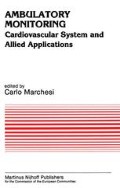Abstract
Computerized analysis of the Holter recordings (ATREC system) identifies only the QRS complexes, thus introducing a limitation in the diagnosis. The formulation of the results cannot use the classical terminology of ECG diagnosis. Despite this limitation, the possibilities of the analysis are large. The computer classifies the QRS complexes as either narrow or wide. The QRSs are analyzed for prematurity, regularity, bradycardia, pauses, transient or continuous tachycardia, and fibrillation. The premature beats are classed by their coupling interval, their distribution in bi- or trigeminy, doublets, or salvos, and the number per hour. The system gives a trend of the mean, and the 16-beat minimum and maximum heart rate. The aim of the computerized analysis is not only to detect the arrhythmias, but also to approach their mechanism, their relationships with the autonomic nervous system and to evaluate the therapeutic results.
Access this chapter
Tax calculation will be finalised at checkout
Purchases are for personal use only
Preview
Unable to display preview. Download preview PDF.
References
Attuel, P., Rosengarten, M.D., Leclercq, J.F., Milosevic, D., Mugica, J. and Coumel, Ph, 1981. Computer quantitated evaluation of cardiac arrhythmias. Pace, 4, 23–35.
Coumel, Ph. 1982. Heart rate trend analysis: patterns and clinical significance. In “Long term ambulatory electrocardiography” (Ed. J. Roelandt and P.G. Hugenholtz). (Martinus Nijhoff, Tha Hague).pp. 51–61.
Coumel, Ph., Attuel, P., Leclercq, J.F., and Friocourt P. 1982a. Arythmies auriculaires d’origine vagale ou catécholergique. Effets comparés du traitement bêta-bloqueur et phénomène d’échappement. Arch. Mal. Coeur, 75, 373–388.
Coumel, Ph., Rosengarten, M.D. Leclercq, J.F., and Attuel, P. 1982b. Role of sympathetic nervous system in non-ischaemic ventricular arrhythmias. Brit. Heart J., 47, 137–143.
Coumel, Ph. 1983. Editorial. Ambulatory electrocardiographic monitoring and the management of arrhythmias. Precision versus inflexibility. Br. Heart J., 49, 201–204.
Coumel, Ph., Leclercq, J.F., Maisonblanche, P., 1983. Analysis of Holter tapes after myocardial infarction: are we looking for the right things ? In “The first year after a myocardial infarction” (Ed. H.E. Kulbertus and H.J.J. Wellens). In press.
Author information
Authors and Affiliations
Editor information
Editors and Affiliations
Rights and permissions
Copyright information
© 1984 ECSC, EEC, EAEC, Brussels-Luxembourg
About this chapter
Cite this chapter
Coumel, P., Leclercq, J.F., Attuel, P. (1984). Computerized Arrhythmia Analysis of the Holter Recordings. In: Marchesi, C. (eds) Ambulatory Monitoring. Developments in Cardiovascular Medicine, vol 37. Springer, Dordrecht. https://doi.org/10.1007/978-94-009-6012-1_7
Download citation
DOI: https://doi.org/10.1007/978-94-009-6012-1_7
Publisher Name: Springer, Dordrecht
Print ISBN: 978-94-009-6014-5
Online ISBN: 978-94-009-6012-1
eBook Packages: Springer Book Archive

